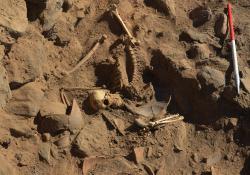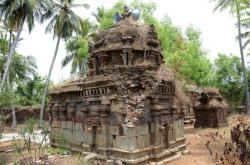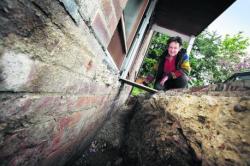INSTITUT SUPERIEUR D'ANTHROPOLOGIE
INSTITUTE OF ANTHROPOLOGY
ONLINE COURSES / COURS A DISTANCE
SUMMER TERM : JULY 2013
REGISTER NOW
EGYPTE –  Hisn al-Bab - A skeleton of a soldier with Nubian characteristcs was discovered during excavations in the Early Byzantine fortress site of Hisn Al-Bab, south of Aswan, in Egypt. According to a formal announcement by the newly appointed Minister of State for Antiquities Dr. Ahmed Essa, the skeleton was brought to light within a residential construction of Heracleian Dynasty date (610-695 AD) by the Austrian Archaeological Institute’s mission (dir. by Dr. Irene Forstner-Müller). As reported, the skeleton is in good condition. It demonstrates that the man, who died at the age of 25 to 35 years old, was of Nubian origins and had served in the army for a long time. He seems to have passed away stabbed at the groin, while his burial seems to had taken place immediately after death. Still, according to Adel Hussein, Director of the Ancient Egyptian Antiquities department, the mission couldn’t determine the time of the outbreak of this particular conflict where the man died. However, preliminary evidence suggests it occurred shortly after the Arab conquest of Egypt.:The fortress at Hisn al-Bab had been a significant border point between Egypt and Nubia. After the Arab conquest it served as a spot where the Nubians were to provide the “baqt”, a number of goods as a kind of tribute to the Arab masters of Egypt, in order to secure peace. So far, two separate phases were identified at Hisn al-Bab. The identification of an earlier, Early Byzantine, fortress of the 6th-7th century was unexpected. This fortress included a large enclosure on the gebel top, walls running down the slope to the river under the later fortress, and areas of what appear to be habitation within the walls. The later fortress, presumably that of al-Qasr, and thus well known from texts, was very well preserved architecturally but surprisingly left almost no other material remains on the surface.
Hisn al-Bab - A skeleton of a soldier with Nubian characteristcs was discovered during excavations in the Early Byzantine fortress site of Hisn Al-Bab, south of Aswan, in Egypt. According to a formal announcement by the newly appointed Minister of State for Antiquities Dr. Ahmed Essa, the skeleton was brought to light within a residential construction of Heracleian Dynasty date (610-695 AD) by the Austrian Archaeological Institute’s mission (dir. by Dr. Irene Forstner-Müller). As reported, the skeleton is in good condition. It demonstrates that the man, who died at the age of 25 to 35 years old, was of Nubian origins and had served in the army for a long time. He seems to have passed away stabbed at the groin, while his burial seems to had taken place immediately after death. Still, according to Adel Hussein, Director of the Ancient Egyptian Antiquities department, the mission couldn’t determine the time of the outbreak of this particular conflict where the man died. However, preliminary evidence suggests it occurred shortly after the Arab conquest of Egypt.:The fortress at Hisn al-Bab had been a significant border point between Egypt and Nubia. After the Arab conquest it served as a spot where the Nubians were to provide the “baqt”, a number of goods as a kind of tribute to the Arab masters of Egypt, in order to secure peace. So far, two separate phases were identified at Hisn al-Bab. The identification of an earlier, Early Byzantine, fortress of the 6th-7th century was unexpected. This fortress included a large enclosure on the gebel top, walls running down the slope to the river under the later fortress, and areas of what appear to be habitation within the walls. The later fortress, presumably that of al-Qasr, and thus well known from texts, was very well preserved architecturally but surprisingly left almost no other material remains on the surface.
http://www.archaiologia.gr/en/blog/2013/05/16/byzantine-era-soldier-skeleton-of-nubian-origin-discovered/
INDE –  Manambadi - A 1,000-year-old Siva temple at Manambadi village near Kumbakonam is facing the threat of demolition for expansion of a road under the Thanjavur-Vikkiravandi four-way project of the National Highways Authority of India (NHAI). The State government's Archaeology Department declared it a protected monument 30 years ago but neglected it, leaving the temple’s vimana in a dilapidated condition and enveloped by creepers. The stone structure below the vimana, with intricate sculptures, and the sanctum sanctorum with a Siva lingam are intact. The temple has an entrance without a gopuram. The prahara has flower plants. A broken compound wall is also around the temple. The NHAI has now decided to demolish this temple for widening the highway and has already marked the portion to be demolished. While the compound wall on the northern side, the Amman temple and the Chandikeswarar temple will be demolished, the road will come very close to the main structure, which may result in its falling apart once the road is put to use. The people of the village, historians and archaeologists have opposed the move and appealed to the State government and NHAI to divert the road project to the extreme northern side of the temple, sparing the structure and protecting the monument. According to Kudavayil Balasubramanian, epigraphist and historian, this temple was constructed by Rajendra Chola (1012-1044 AD). During Chola rule, the village was called ‘Elaichikudi’, and ‘Veeranarayanapuram’. The temple’s name was ‘Sri Kailasam’. “This temple possesses more than ten inscriptions of the Chola period. Some of the sculptures on the walls of the main structure are those of Nataraja, which is an outstanding one. Another sculpture depicting Rajendra Chola worshipping the Lord with his wives is seen. Other sculptures depict Ganapathi, Dakshinamurthy, Ligotpava, Vishnu, Brahma, Gangadharamurthy, Durga and Arthanari. Among Chola sculptures, they are the unique ones,” Balasubramanian said.
Manambadi - A 1,000-year-old Siva temple at Manambadi village near Kumbakonam is facing the threat of demolition for expansion of a road under the Thanjavur-Vikkiravandi four-way project of the National Highways Authority of India (NHAI). The State government's Archaeology Department declared it a protected monument 30 years ago but neglected it, leaving the temple’s vimana in a dilapidated condition and enveloped by creepers. The stone structure below the vimana, with intricate sculptures, and the sanctum sanctorum with a Siva lingam are intact. The temple has an entrance without a gopuram. The prahara has flower plants. A broken compound wall is also around the temple. The NHAI has now decided to demolish this temple for widening the highway and has already marked the portion to be demolished. While the compound wall on the northern side, the Amman temple and the Chandikeswarar temple will be demolished, the road will come very close to the main structure, which may result in its falling apart once the road is put to use. The people of the village, historians and archaeologists have opposed the move and appealed to the State government and NHAI to divert the road project to the extreme northern side of the temple, sparing the structure and protecting the monument. According to Kudavayil Balasubramanian, epigraphist and historian, this temple was constructed by Rajendra Chola (1012-1044 AD). During Chola rule, the village was called ‘Elaichikudi’, and ‘Veeranarayanapuram’. The temple’s name was ‘Sri Kailasam’. “This temple possesses more than ten inscriptions of the Chola period. Some of the sculptures on the walls of the main structure are those of Nataraja, which is an outstanding one. Another sculpture depicting Rajendra Chola worshipping the Lord with his wives is seen. Other sculptures depict Ganapathi, Dakshinamurthy, Ligotpava, Vishnu, Brahma, Gangadharamurthy, Durga and Arthanari. Among Chola sculptures, they are the unique ones,” Balasubramanian said.
http://www.thehindu.com/news/national/tamil-nadu/1000yearold-cholaera-temple-facing-threat-of-demolition/article4718623.ece
ROYAUME UNI –  Wallingford - The discovery of a skeleton in the back garden of a home in Wallingford has revealed the location of a lost Saxon church. Now it has emerged the skeleton proves for the first time the precise location of St Lucian’s, one of the town’s oldest known churches. Mrs Dewey, from Cholsey, added that the human remains probably dated from the 12th or 13th century. She added: “St Lucian’s Church pre-dates the Norman Conquest, so this is an exciting discovery.”
Wallingford - The discovery of a skeleton in the back garden of a home in Wallingford has revealed the location of a lost Saxon church. Now it has emerged the skeleton proves for the first time the precise location of St Lucian’s, one of the town’s oldest known churches. Mrs Dewey, from Cholsey, added that the human remains probably dated from the 12th or 13th century. She added: “St Lucian’s Church pre-dates the Norman Conquest, so this is an exciting discovery.”
http://www.oxfordmail.co.uk/news/10422125.Skeleton_find_reveals_long_lost_church_site/